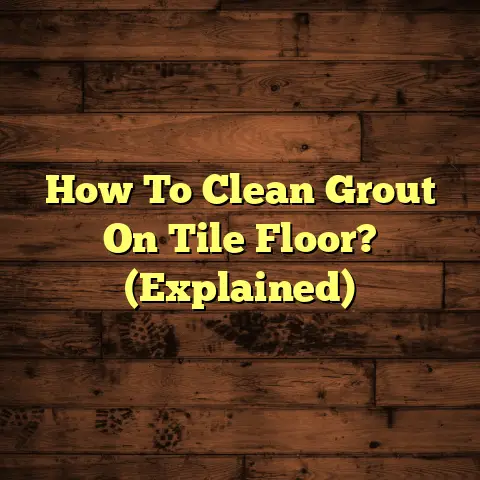Why Are My Hardwood Floors So Creaky?
I still remember the first time I stepped onto my hardwood floors after they had been newly installed. The beautiful grain, the smooth finish, it truly felt like walking on art. But over time, I began to notice something unsettling: the floors started to creak. At first, it was just a few annoying noises here and there, but as the months went by, it became a symphony of creaks and groans, especially in the early morning when the house was quiet. Have you ever experienced this?
Why Are My Hardwood Floors So Creaky?
Creaky hardwood floors can be frustrating, and I’ve spent a good amount of time troubleshooting the issue. It’s not uncommon, especially in older houses or homes with fluctuating humidity levels. Let me share some insights I’ve gathered over the years.
Common Causes of Creaky Floors
- Humidity and Temperature Changes
One of the primary reasons for creaky floors is changes in humidity and temperature. Wood is a natural material that expands and contracts with moisture levels. In summer, high humidity can cause the wood to swell, while in winter, dry air can lead to shrinkage. When the boards move against each other or the subfloor, you’ll hear those annoying creaks. I recall a winter where my floors were particularly noisy. After researching, I discovered that maintaining a consistent humidity level in the house can reduce these fluctuations. A humidifier has been a lifesaver for me during those dry months. - Improper Installation
Another reason for creaky hardwood floors can be improper installation. If the flooring wasn’t laid down correctly, or if there was insufficient fastening to the subfloor, you might hear creaking sounds as the boards shift. I once worked on a project where the contractor used too few nails—sure enough, the homeowner called me back about a year later with complaints of creaking. - Wear and Tear
Over time, wear and tear can also contribute to creaky floors. As the floor ages, the nails holding the boards in place can loosen, leading to more movement and noise. Regular maintenance is key here. I recommend checking your floors periodically for any loose nails and reapplying them as needed. - Subfloor Issues
Sometimes, it’s not just the hardwood itself causing the noise but the subfloor beneath it. If the subfloor is uneven or damaged, it may lead to movement that translates into creaks. I’ve encountered situations where fixing or replacing sections of subflooring eliminated creaks almost entirely.
How to Fix Creaky Floors
Now that we know what causes creaky floors, let’s discuss some practical solutions based on my experiences.
- Screw Down Loose Boards
If you suspect that loose boards are the issue, one effective fix is to screw them down to the subfloor. Use 1-1/4 inch screws to secure any loose planks without going through the surface. This method has worked wonders for me as it stabilizes the floor while minimizing further noise. - Lubricate Between Boards
Another method I’ve tried is using powdered graphite or talcum powder between the floorboards. This helps reduce friction and can quiet down those annoying sounds. Just sprinkle a small amount between the boards and work it in gently with a soft brush. - Use Shims
If you have an uneven subfloor, adding shims can help level things out. I once had a client whose home had significant settling issues. By placing shims under certain boards, I was able to reduce movement and silence those pesky creaks. - Adjust Humidity Levels
As mentioned earlier, keeping humidity levels stable is crucial. A good humidifier can help during dry seasons, while dehumidifiers work wonders in damp conditions. I’ve found that maintaining around 30%-50% humidity keeps my floors happy. - Consult a Professional
If all else fails, it may be best to consult a flooring professional who can assess your specific situation. Sometimes, a trained eye can spot underlying issues that might not be obvious to you.
Cost Considerations
When dealing with flooring issues, cost is always a concern. Here’s how FloorTally helps me manage budgeting effectively during installations and repairs.
Using FloorTally has enabled me to create accurate cost estimates quickly by pulling local material and labor rates. For instance, if I need to replace sections of subflooring or install new hardwood planks due to wear and tear, I can input all necessary details—such as square footage and material choices—and receive an immediate estimate.
For example, if I’m working on a 1,000 square foot area needing new hardwood due to excessive creaking from instability, FloorTally provides quick calculations of both materials and labor costs. This way, clients have realistic budget expectations from the start.
Successes and Challenges
Throughout my career as a flooring contractor, I’ve seen both success stories and challenges when it comes to creaky floors.
One memorable success involved a family living in an older home with notoriously loud floors. After assessing their situation and applying several of the fixes mentioned above—like securing loose boards and stabilizing humidity levels—we managed to significantly reduce noise levels. The family was overjoyed with their newfound peace!
However, there have also been challenges. In another case, I encountered severe subfloor issues that required extensive repairs before we could even think about addressing the hardwood floors themselves. This not only extended project timelines but also increased costs for my client unexpectedly.
Tips for Maintaining Hardwood Floors
To keep your hardwood floors in top shape and prevent creaking from occurring in the first place, here are some tips I’ve gathered over the years:
- Regular Cleaning: Keeping dirt and debris off your floors helps minimize scratches and wear.
- Use Furniture Pads: Place pads under furniture legs to avoid indentations that can affect floor stability.
- Avoid Excessive Water: Water can warp wood; always clean spills promptly and use minimal liquid when mopping.
- Schedule Regular Inspections: A yearly inspection can help catch issues before they escalate into bigger problems.
By following these tips and understanding the potential causes of creaking floors, you can maintain your hardwood flooring effectively.
Detailed Look at Installation Techniques
Understanding how hardwood flooring is installed can help you appreciate why creaking occurs and how to prevent it in future projects.
Nail-Down Installation
This technique involves nailing planks directly to the subfloor using pneumatic nail guns or manual methods. It’s commonly used for solid hardwood floors and is generally effective in minimizing noise if done correctly.
- Pros: Strong hold; good for solid wood.
- Cons: Can be noisy during installation; may expand/contract over time if not installed properly.
I’ve seen both successes and failures with nail-down installations depending on how well they were executed. Ensuring that nails are driven straight and at appropriate intervals minimizes movement later on.
Glue-Down Installation
With this method, adhesive is spread out on the subfloor before laying down planks. This approach works well for engineered wood and can help reduce noise since the glue creates a bond that dampens sound.
- Pros: Reduces noise; can be effective on concrete subfloors.
- Cons: Messy; requires careful application; potential for adhesive failure over time.
In one project where I used glue-down techniques for engineered wood floors in a high-rise building, clients reported minimal noise even after years of use!
Floating Installation
Floating floors are not attached directly to the subfloor but instead “float” above it using interlocking planks or tongue-and-groove systems. This method is popular for both laminate and engineered wood flooring.
- Pros: Easy installation; good for DIY projects; allows for expansion.
- Cons: Can be noisier if not installed properly; movement may cause creaking if not leveled correctly.
I often recommend this method for clients looking for quick installations without long drying times associated with glue-down methods.
Understanding Wood Types
The species of hardwood also plays a crucial role in how likely your floors are to creak over time:
- Oak
Oak is one of the most common choices for hardwood flooring because of its durability and resistance to wear. It tends to handle humidity changes better than softer woods but may still experience some movement over time. - Maple
Maple is denser and less prone to denting but can be more susceptible to environmental changes that lead to noise if not installed correctly. - Cherry
Cherry has beautiful coloring but is softer than oak or maple; thus, it may wear more quickly under heavy traffic or shifting conditions. - Hickory
Hickory is known for its strength and hardness but can be prone to expansion and contraction due to moisture changes.
Choosing the right wood type for your environment can make a significant difference in long-term performance.
Environmental Factors Affecting Hardwood Floors
Seasonal Changes
As seasons shift from hot summers to cold winters, fluctuations in temperature and humidity can impact hardwood flooring greatly. This is an area where clients often overlook preventive measures until it’s too late.
For instance, during summer months when humidity rises, wood flooring tends to expand—leading to potential buckling or gaps when it contracts again in winter months.
Home Location
Where your home is located also matters; coastal homes may face different challenges than those in dryer regions due to varying moisture levels.
Living in an area with heavy rainfall or high humidity calls for additional precautions like dehumidifiers or proper insulation systems that protect against excess moisture entering your home.
The Role of Subfloors
The condition of subfloors beneath hardwood flooring cannot be overstated. An unstable or uneven subfloor can lead not only to creaking but also to more significant structural issues over time.
Checking Subfloor Integrity
Before installing new hardwood floors or repairing existing ones, always check your subfloor’s condition:
- Look for signs of moisture damage: Any warping or discoloration indicates potential problems.
- Confirm leveling: Use a level tool across various points; any significant dips or bumps should be addressed before laying new flooring.
- Inspect for pests: Wood-boring insects can compromise structural integrity; seeking professional pest control before installation is prudent.
Maintenance Best Practices
Taking care of your hardwood flooring goes beyond simply cleaning—it requires ongoing vigilance regarding both visible and hidden issues:
- Routine Cleaning
- Sweep or vacuum regularly.
- Use appropriate cleaning solutions designed specifically for hardwood floors.
- Avoid waterlogged mops that leave excess moisture behind.
- Protective Measures
- Use door mats at entrances to capture dirt tracked inside.
- Avoid wearing high heels or heavy shoes indoors that could dent or scratch surfaces.
- Arrange furniture carefully—consider moving heavy pieces around often to prevent permanent indentations in your floor’s finish.
Dealing with Major Repairs
Sometimes creaking floors indicate deeper issues requiring major repairs rather than simple fixes like tightening screws or adjusting humidity levels:
- Full Replacement
- If noise persists despite all efforts, full replacement may be necessary.
- A professional assessment will help determine whether existing boards need complete removal due to extensive damage from water or pests.
- Reinforcing Subfloors
- In severe cases involving sagging subfloors beneath hardwood installations, reinforcing these structures through additional support beams may be necessary.
- This process involves significant labor but often yields lasting results that eliminate creaking issues entirely!
Conclusion: Finding Peace with Your Floors
Dealing with creaky hardwood floors can be frustrating but not insurmountable. With a little knowledge and some proactive measures, you can minimize those annoying sounds and enjoy your beautiful flooring to its fullest potential.
Whether it’s adjusting humidity levels or tightening loose boards, there are many paths to silence those creaks for good. And remember—if you’re ever in doubt, reaching out for professional help could save you time and money in the long run.
So next time you hear a creak beneath your feet, instead of feeling annoyed, consider it an opportunity to make your home even cozier and more inviting!





